Experimental and Computational Analysis of Aluminum-Coated Dimple and Plain Tubes in Solar Water Heater System
Abstract
:1. Introduction
| Refs. | Types/Methods | Observations |
|---|---|---|
| [14] | Parabolic Trough Collector (PTC) | To improve the optical and thermal properties of parabolic trough collectors. |
| [27] | Phase-Change Materials (PCMs) | To improve energy and exergy efficiency and the time, it takes to recoup its costs. |
| [28] | Circular Parabolic Absorber (CPA) | Improve the absorber with a good design, performance, and output, made solar tracking a reality in this system. |
| [26] | Compound Parabolic Concentrating (CPC) | To improve the thermal efficiency. |
| [29] | Parabolic Dish Solar Geyser (PDSG) | To improve the thermal performance of a solar geyser was tested using this approach with three flow rates. |
2. Materials and Methods
2.1. Details of Experiment and Data Collection
2.2. Thermodynamic Evaluation
2.3. Evaluation of Pressure Drop and Frictional Loss
2.4. Uncertainty Assessment
2.5. Evaluation of the Mean Flow’s Governing Equations
2.6. Tests of Grid Independence
2.7. Velocity Flow
2.8. Temperature Analysis
3. Results and Discussion
3.1. Thermal Efficiency
3.2. Friction Factor
3.3. Roughness Pitch
3.4. Convective Heat Transfer
3.5. Evaluation of Nusselt Number
3.6. Economic Evaluation
3.7. Effectiveness Analysis
4. Conclusions
Author Contributions
Funding
Data Availability Statement
Acknowledgments
Conflicts of Interest
Nomenclature
| Symbol | Definition |
| Working fluid’s temperature rise | |
| Water–fluid mix | |
| Pressure components | |
| Irradiance intensity | |
| Heat transfer rate | |
| Little quantity of heat | |
| Multiplied aperture area | |
| Radiation’s exergy | |
| Fluid’s specific heat capacity | |
| Thermal expansion coefficients | |
| Quantity of water | |
| Instantaneous efficiency | |
| Sloping roof surface | |
| Absorb more heat at a lower flow rate | |
| Thermal loss | |
| Increase in usable energy | |
| Transferred to a fluid | |
| Velocity factors | |
| Ambient temperature | |
| Mass flow rates increases | |
| Decreases at low mass flow rates | |
| Sensible heat | |
| Convection | |
| Radiation | |
| ,,…, | Uncertainties in the independent variable |
| Outer receiver | |
| Thermal efficiency | |
| ,,…, | Relevant factors |
| Outflow | |
| Radiation heat movement output | |
| Installation costs | |
| Density | |
| The temperature of the protective plate | |
| Mass flow rate | |
| Incompressible fluid | |
| Temperature | |
| Incompressible | |
| Turbulent flow | |
| Thermocouple and a heated vision device |
References
- Khargotra, R.; Kumar, S.; Kumar, R. Influence of hindrance promoter on the thermal augmentation factor of solar water heater (an experimental study). Renew. Energy 2021, 163, 1356–1369. [Google Scholar] [CrossRef]
- Li, W.; Yu, Z. Heat exchangers for cooling supercritical carbon dioxide and heat transfer enhancement: A review and assessment. Energy Rep. 2021, 7, 4085–4105. [Google Scholar] [CrossRef]
- Zheng, G.; Zhang, W.; Man, C.; Sun, P. Thermal Characteristics of a Heat Exchanger Tube Fitted with Different Peripherally-Cut Twisted Tape Inserts In Laminar Flow. Heat Transf. Res. 2021, 52, 29–42. [Google Scholar] [CrossRef]
- Arun, M.; Barik, D.; Sridhar, K.; Vignesh, G. Performance Analysis of Solar Water Heater Using Al2O3 NanoParticle with Plain-Dimple Tube Design. Exp. Tech. 2022, 46, 993–1006. [Google Scholar] [CrossRef]
- Ajbar, W.; Parrales, A.; Huicochea, A.; Hernández, J. Different ways to improve parabolic trough solar collectors’ performance over the last four decades and their applications: A comprehensive review. Renew. Sustain. Energy Rev. 2022, 156, 111947. [Google Scholar] [CrossRef]
- Thalib, M.M.; Vimala, M.; Manokar, A.M.; Sathyamurthy, R.; Sadeghzadeh, M.; Sharifpur, M. Energy, exergy and economic investigation of passive and active inclined solar still: Experimental study. J. Therm. Anal. 2021, 145, 1091–1102. [Google Scholar] [CrossRef]
- Nazir, M.S.; Shahsavar, A.; Afrand, M.; Arıcı, M.; Nižetić, S.; Ma, Z.; Öztop, H.F. A comprehensive review of parabolic trough solar collectors equipped with turbulators and numerical evaluation of hydrothermal performance of a novel model. Sustain. Energy Technol. Assess. 2021, 45, 101103. [Google Scholar]
- Vengadesan, E.; Senthil, R. Experimental study on the thermal performance of a flat plate solar water collector with a bifunctional flow insert. Sustain. Energy Technol. Assess. 2022, 50, 101829. [Google Scholar] [CrossRef]
- Goel, V.; Hans, V.; Singh, S.; Kumar, R.; Pathak, S.K.; Singla, M.; Bhattacharyya, S.; Almatrafi, E.; Gill, R.; Saini, R. A comprehensive study on the progressive development and applications of solar air heaters. Sol. Energy 2021, 229, 112–147. [Google Scholar] [CrossRef]
- Ajarostaghi, S.S.M.; Zaboli, M.; Javadi, H.; Badenes, B.; Urchueguia, J.F. A Review of Recent Passive Heat Transfer Enhancement Methods. Energies 2022, 15, 986. [Google Scholar] [CrossRef]
- Hussein, H.A.M.; Zulkifli, R.; Mahmood, W.M.F.B.W.; Ajeel, R.K. Structure parameters and designs and their impact on performance of different heat exchangers: A review. Renew. Sustain. Energy Rev. 2022, 154, 111842. [Google Scholar] [CrossRef]
- Zaboli, M.; Ajarostaghi, S.S.M.; Saedodin, S.; Kiani, B. Hybrid nanofluid flow and heat transfer in a parabolic trough solar collector with inner helical axial fins as turbulator. Eur. Phys. J. Plus 2021, 136, 841. [Google Scholar] [CrossRef]
- Sharma, S.; Das, R.K.; Kulkarni, K. Computational and experimental assessment of solar air heater roughened with six different baffles. Case Stud. Therm. Eng. 2021, 27, 101350. [Google Scholar] [CrossRef]
- Naveenkumar, R.; Ravichandran, M.; Stalin, B.; Ghosh, A.; Karthick, A.; Aswin, L.S.R.L.; Priyanka, S.S.H.; Kumar, S.P.; Kumar, S.K. Comprehensive review on various parameters that influence the performance of parabolic trough collector. Environ. Sci. Pollut. Res. 2021, 28, 22310–22333. [Google Scholar] [CrossRef]
- Deepika, K.; Sarviya, R. Application based review on enhancement of heat transfer in heat exchangers tubes using inserts. Mater. Today Proc. 2021, 44, 2362–2365. [Google Scholar] [CrossRef]
- Arun, M.; Barik, D.; Sridhar, K.; Vignesh, G. Experimental and CFD analysis of plain and dimples tube at application of solar water heater. Mater. Today Proc. 2021, 42, 804–809. [Google Scholar] [CrossRef]
- Khargotra, R.; Kumar, R.; Kumar, S. Impact of perforated shapes in delta type hindrance promoter on thermo-hydraulic performance of solar water heating system (An experimental study). Case Stud. Therm. Eng. 2021, 24, 100831. [Google Scholar] [CrossRef]
- Mashkour, M.A.; Majdi, H.S.; Habeeb, L.J. Enhancement of Forced Convection Heat Transfer in Tubes and Heat Exchangers Using Passive Techniques: A review. J. Mech. Eng. Res. Dev. 2021, 44, 208–218. [Google Scholar]
- Vasanthi, P.; Reddy, G.J.C. Experimental investigations on heat transfer and friction factor of hybrid nanofliud equiped with angular twisted strip inserts in a parabolic trough solar collector under turbulent flow. Int. J. Innov. Sci. Eng. Technol. 2021, 8, 1. [Google Scholar]
- Wang, Y.; Zong, S.; Song, Y.; Cao, F.; He, Y.; Gao, Q. Experimental and techno-economic analysis of transcritical CO2 heat pump water heater with fin-and-tube and microchannel heat exchanger. Appl. Therm. Eng. 2021, 199, 117606. [Google Scholar] [CrossRef]
- Kumar, P.G.; Balaji, K.; Sakthivadivel, D.; Vigneswaran, V.; Velraj, R.; Kim, S.C. Enhancement of heat transfer in a combined solar air heating and water heater system. Energy 2021, 221, 119805. [Google Scholar] [CrossRef]
- Bassem, S.; Jalil, J.M.; Ismael, S.J. Experimental Study of Double Pass water passage in Evacuated Tube with Parabolic Trough Collector. In Journal of Physics: Conference Series; IOP Publishing: Bristol, UK, 2021; Volume 1973, No. 1; p. 012058. [Google Scholar] [CrossRef]
- Sakhaei, S.A.; Valipour, M.S. Thermal behavior of a flat plate solar collector with simultaneous use of helically heat collecting tubes and phase change materials. Sustain. Energy Technol. Assess. 2021, 46, 101279. [Google Scholar] [CrossRef]
- Dinesh, S.; Ravi, S.; Kumar, P.M.; Subbiah, R.; Karthick, A.; Saravanakumar, P.; Pranav, R.A. Study on an ETC solar water heater using flat and wavy diffuse reflectors. Mater. Today Proc. 2021, 47, 5228–5232. [Google Scholar] [CrossRef]
- Kumar, P.M.; Kumar, C.S.; Muralidharan, K.; Muniratnam, Y.; Abraham, K.; Manikandan, V.; Stalin, P.M.J.; Prasanth, S.J. Augmenting the performance of conventional solar still through the nano-doped black paint (NDBP) coating on absorber. Mater. Today Proc. 2021, 47, 4929–4933. [Google Scholar] [CrossRef]
- Arnaoutakis, N.; Vouros, A.P.; Milousi, M.; Caouris, Y.G.; Panaras, G.; Tourlidakis, A.; Vafiadis, K.; Mihalakakou, G.; Garoufalis, C.S.; Frontistis, Z.; et al. Design, Energy, Environmental and Cost Analysis of an Integrated Collector Storage Solar Water Heater Based on Multi-Criteria Methodology. Energies 2022, 15, 1673. [Google Scholar] [CrossRef]
- Pandey, A.; Laghari, I.A.; Kumar, R.R.; Chopra, K.; Samykano, M.; Abusorrah, A.M.; Sharma, K.; Tyagi, V. Energy, exergy, exergoeconomic and enviroeconomic (4-E) assessment of solar water heater with/without phase change material for building and other applications: A comprehensive review. Sustain. Energy Technol. Assess. 2021, 45, 101139. [Google Scholar] [CrossRef]
- Elshamy, S.M.; El-Said, E.M.; Panchal, H.; El-Tahan, H.R. Performance assessment of a solar water distiller using circular parabolic absorber: An experimental investigation. Case Stud. Therm. Eng. 2021, 28, 101508. [Google Scholar] [CrossRef]
- Sagade, A.A.; Mawire, A.; Belgasim, B.; Tawfik, M.; Sagade, N.A. Experimental performance evaluation of a parabolic dish solar geyser using a generalized approach for decentralized applications. Sustain. Energy Technol. Assess. 2021, 47, 101454. [Google Scholar] [CrossRef]
- Arun, M.; Barik, D.; Sridhar, K.P. Experimental and CFD analysis of dimple tube parabolic trough solar collector (PTSC) with TiO2 nanofluids. J. Therm. Anal. Calorim. 2022, 147, 14039–14056. [Google Scholar] [CrossRef]
- Devarakonda, A.K.; Karuppiah, N.; Selvaraj, T.; Balachandran, P.K.; Shanmugasundaram, R.; Senjyu, T. A Comparative Analysis of Maximum Power Point Techniques for Solar Photovoltaic Systems. Energies 2022, 15, 8776. [Google Scholar] [CrossRef]
- Radchenko, A.; Radchenko, M.; Koshlak, H.; Radchenko, R.; Forduy, S. Enhancing the Efficiency of Integrated Energy Systems by the Redistribution of Heat Based on Monitoring Data. Energies 2022, 15, 8774. [Google Scholar] [CrossRef]
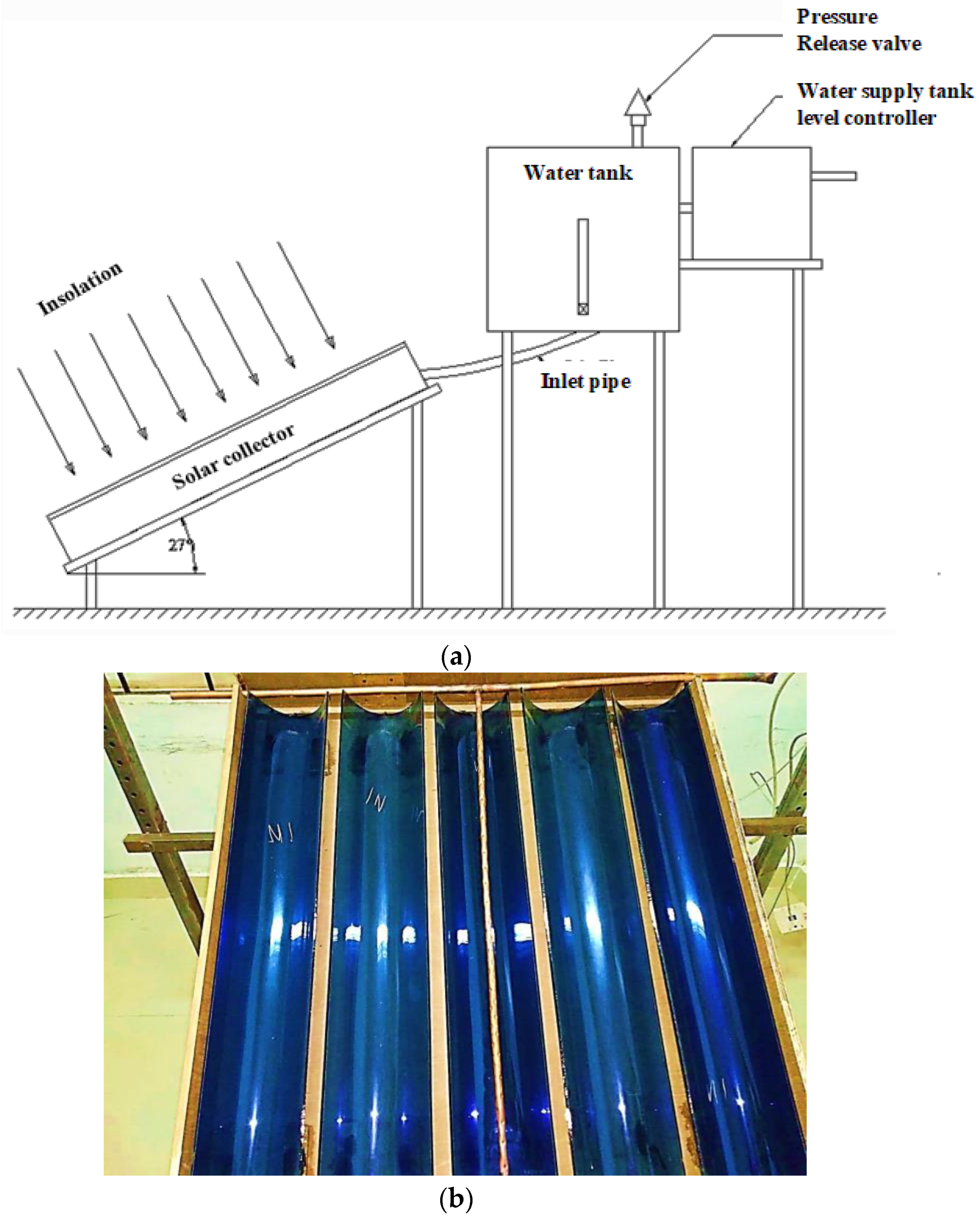
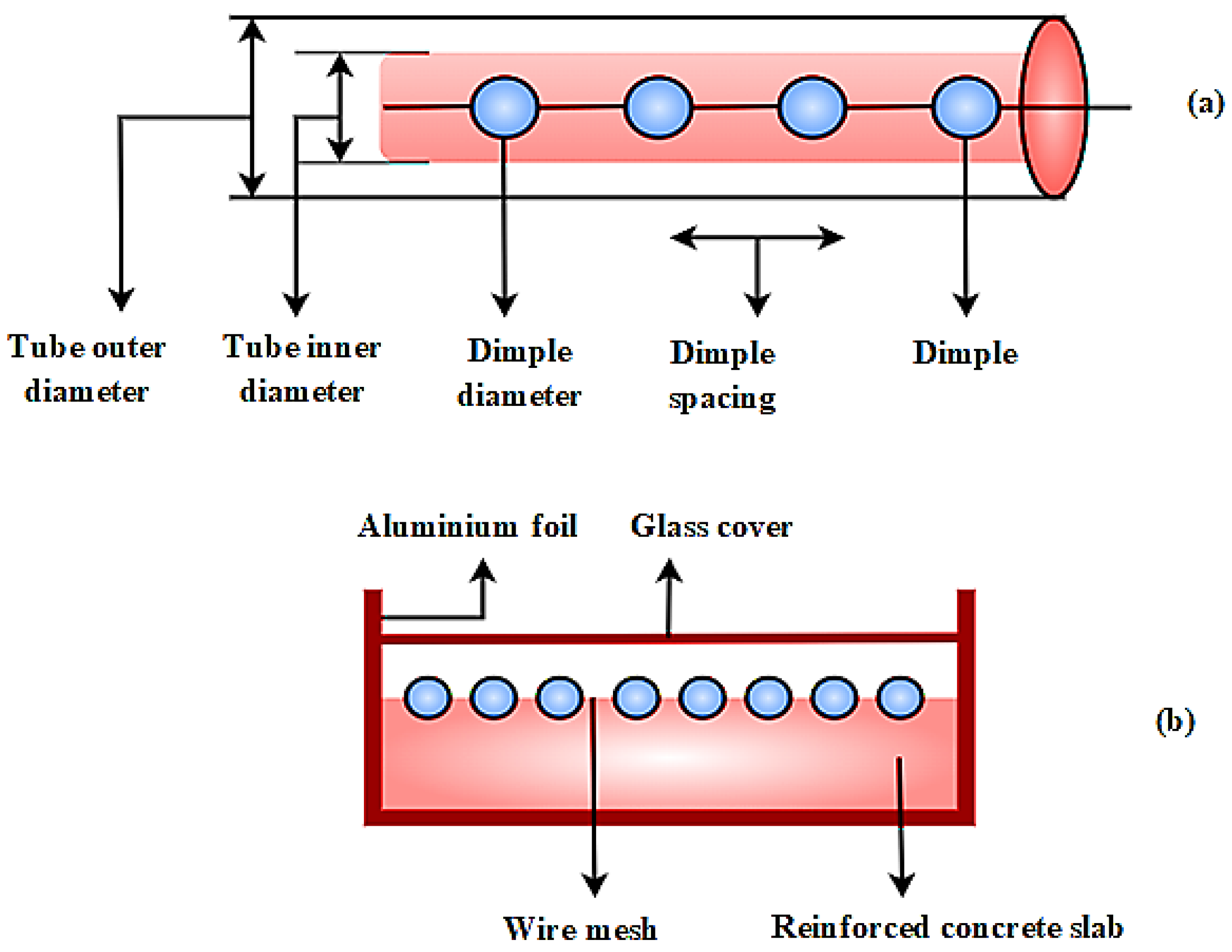
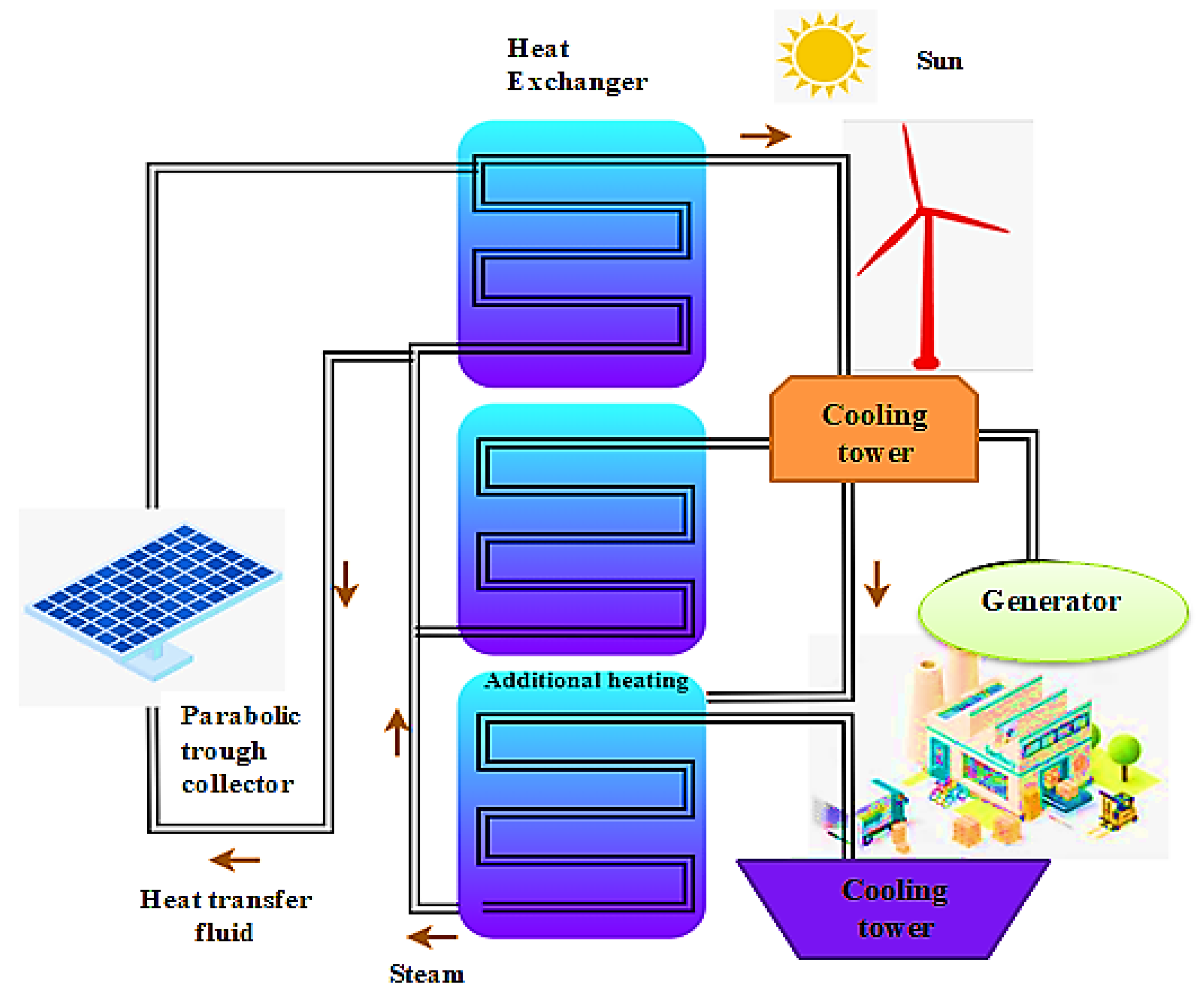
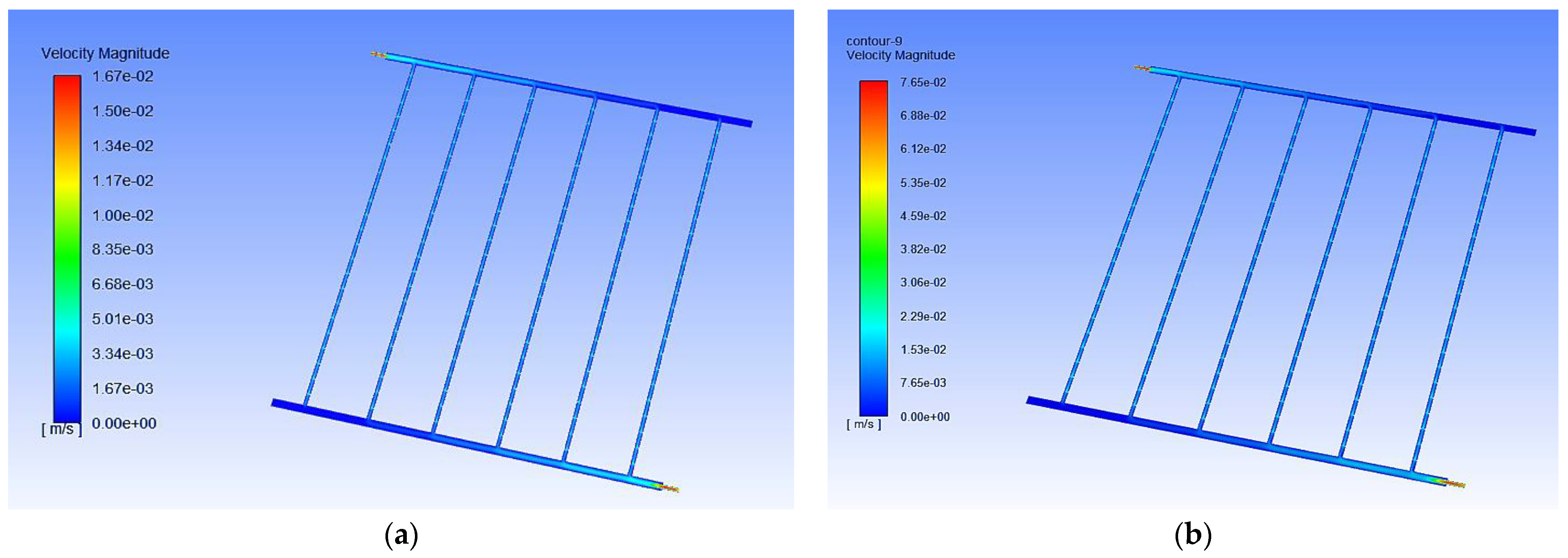
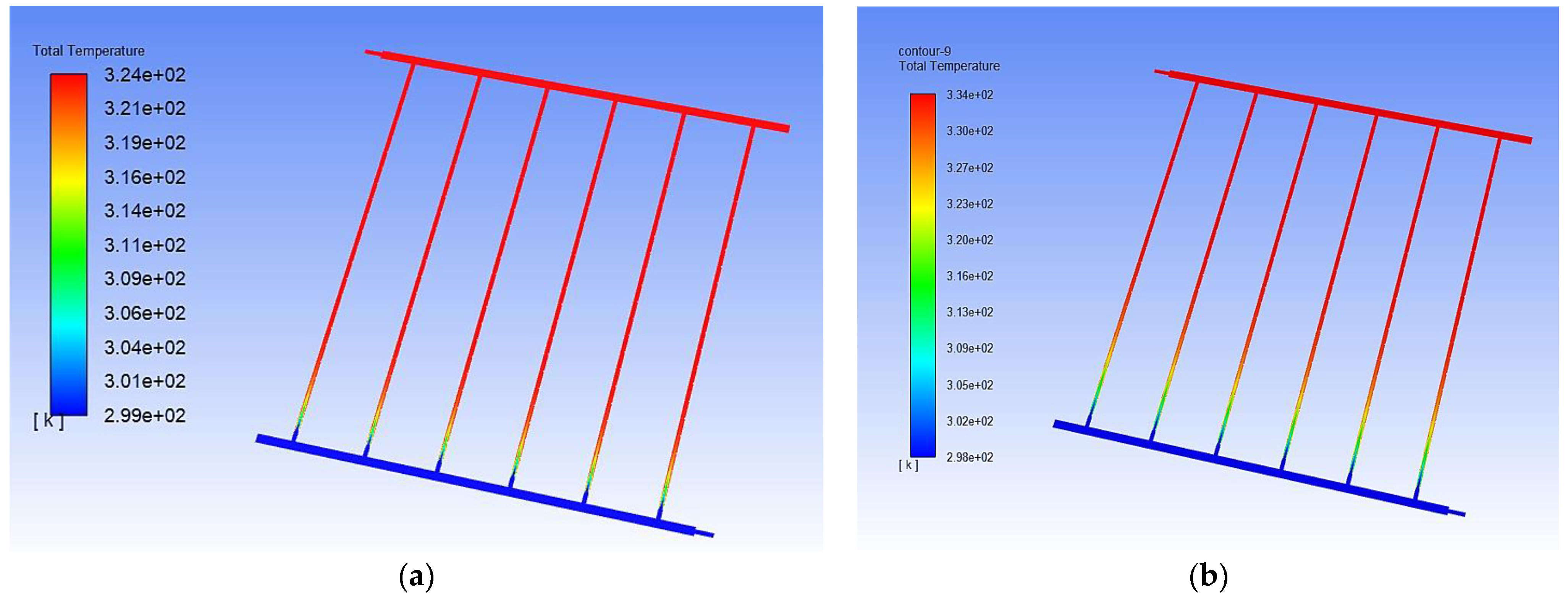


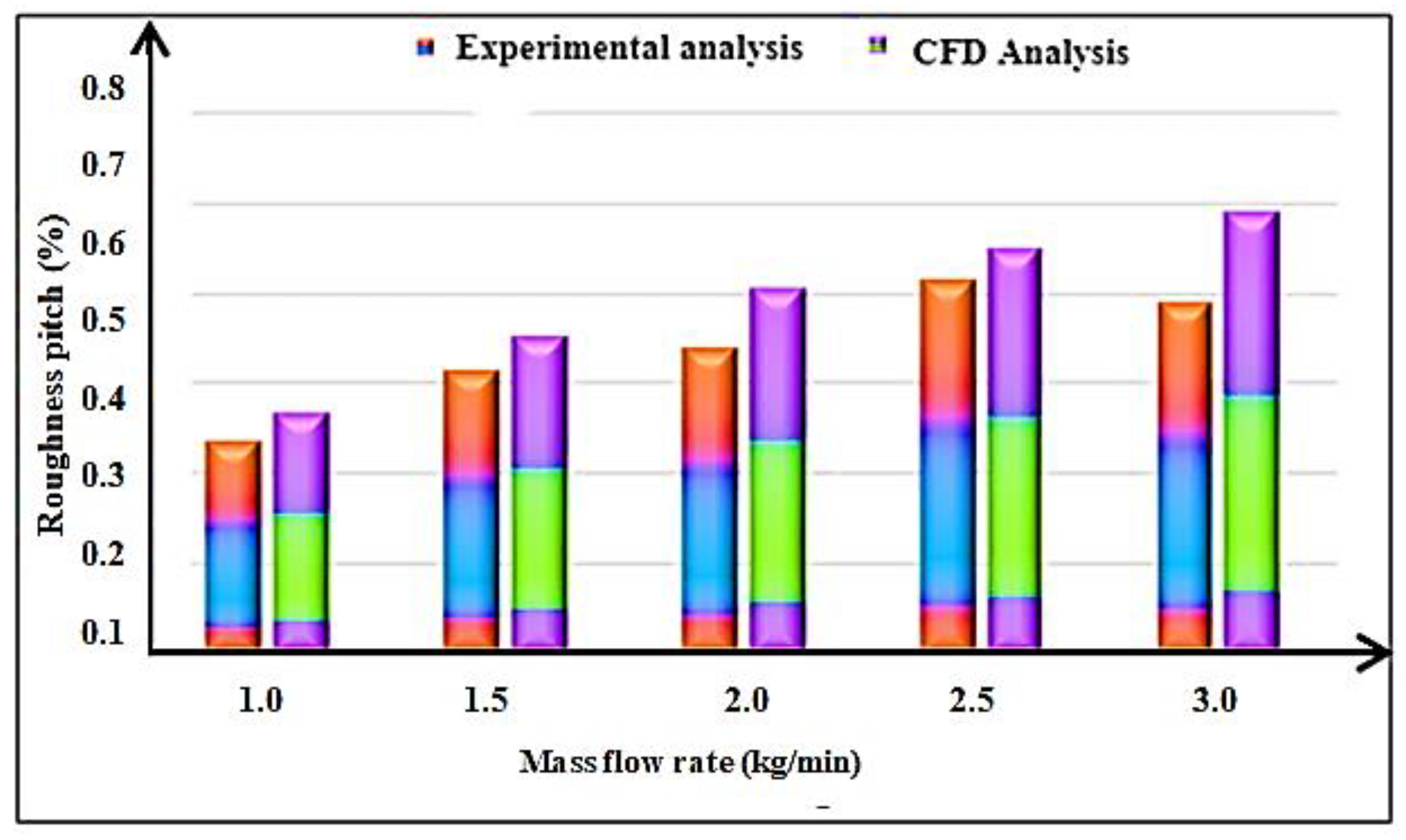



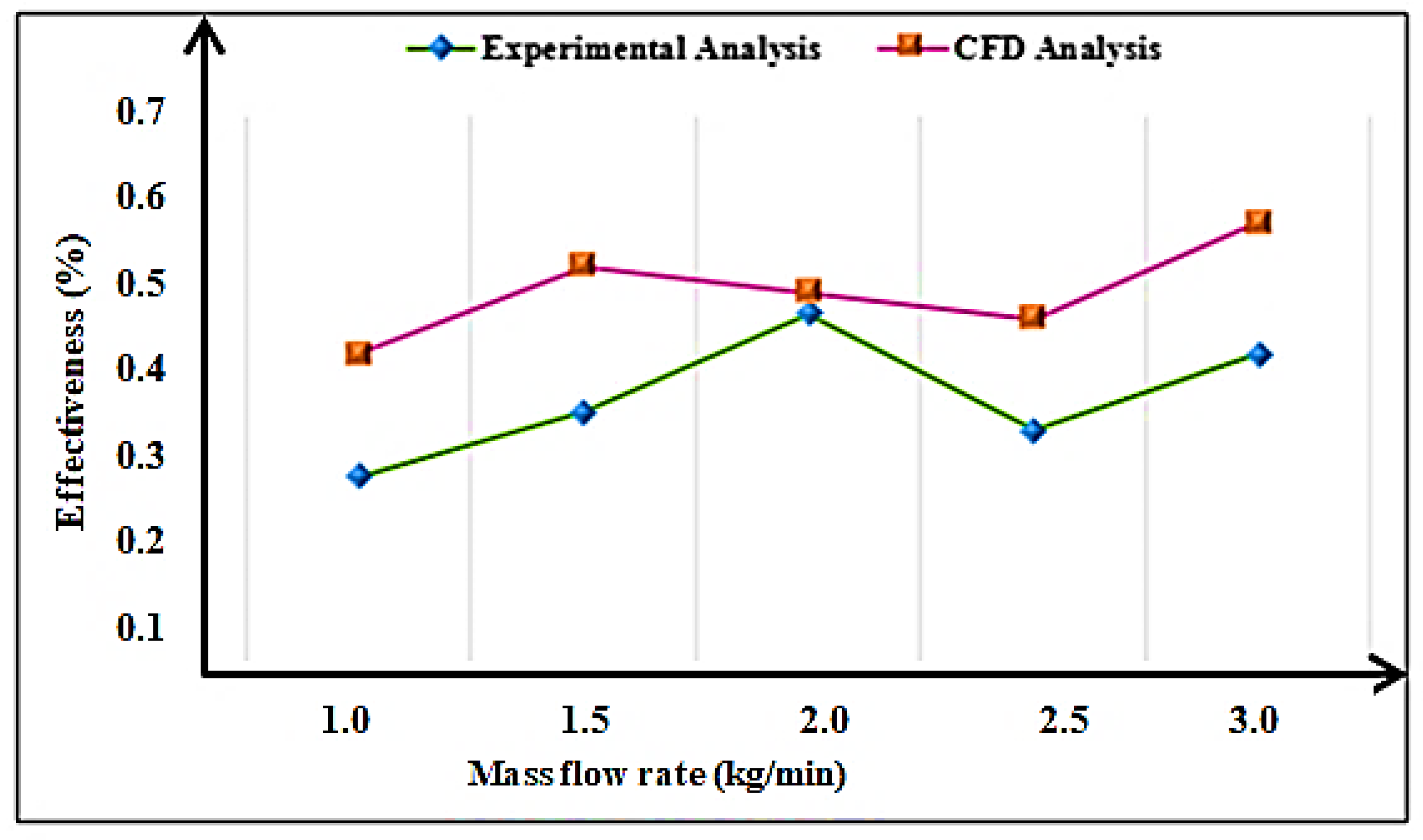
| Specification | Dimensions |
|---|---|
| Width of collector | 1.3 m |
| Collector length | 1.7 m |
| Absorber plate thermal conductivity | 385 W/mK |
| Length of absorber Plate | 1.630 m |
| Thickness of plate | 6 cm |
| Width of the absorber plate | 1000 mm |
| Riser pipe diameter | 0.0130 m |
| The density of plate material | 8958 kg/m3 |
| The riser and head of thickness | 8 cm |
| Header pipe diameter | 2.7 cm |
| Riser tube thickness | 2 mm |
| Glass and absorber plate between the spacing | 40 cm |
| Centre to center distance of the tube | 11.35 cm |
| The density of insulation material | 300 kg/m3 |
| Thermal conductivity of insulation material | 0.054 W/m K |
| Absorber plate area | 1060 mm × 1000 mm |
| Insulation material thickness | 0.06 m |
Disclaimer/Publisher’s Note: The statements, opinions and data contained in all publications are solely those of the individual author(s) and contributor(s) and not of MDPI and/or the editor(s). MDPI and/or the editor(s) disclaim responsibility for any injury to people or property resulting from any ideas, methods, instructions or products referred to in the content. |
© 2022 by the authors. Licensee MDPI, Basel, Switzerland. This article is an open access article distributed under the terms and conditions of the Creative Commons Attribution (CC BY) license (https://creativecommons.org/licenses/by/4.0/).
Share and Cite
Barik, D.; M., A.; Saeed, M.A.; Ramachandran, T. Experimental and Computational Analysis of Aluminum-Coated Dimple and Plain Tubes in Solar Water Heater System. Energies 2023, 16, 295. https://doi.org/10.3390/en16010295
Barik D, M. A, Saeed MA, Ramachandran T. Experimental and Computational Analysis of Aluminum-Coated Dimple and Plain Tubes in Solar Water Heater System. Energies. 2023; 16(1):295. https://doi.org/10.3390/en16010295
Chicago/Turabian StyleBarik, Debabrata, Arun M., Muhammad Ahsan Saeed, and Tholkappiyan Ramachandran. 2023. "Experimental and Computational Analysis of Aluminum-Coated Dimple and Plain Tubes in Solar Water Heater System" Energies 16, no. 1: 295. https://doi.org/10.3390/en16010295
APA StyleBarik, D., M., A., Saeed, M. A., & Ramachandran, T. (2023). Experimental and Computational Analysis of Aluminum-Coated Dimple and Plain Tubes in Solar Water Heater System. Energies, 16(1), 295. https://doi.org/10.3390/en16010295








